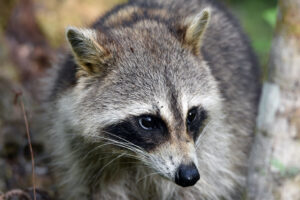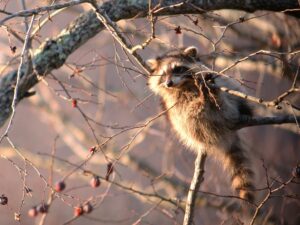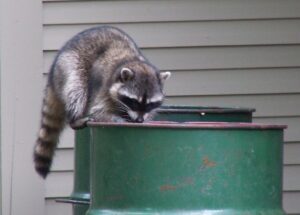About Raccoons
Informally known as “trash pandas,” raccoons are known both for their cuteness and their mischief. They have round, gray bodies with a coat of thick fur and bushy tail, as well as a pointed nose and a characteristic black “bandit” mask across their eyes. This mask is said to reduce the sun’s glare. They vary in size and usually weigh between 12 and 36 pounds. Their front paws have five toes which can easily grab onto and hold objects. Their diet usually consists of insects, berries or fruits, bird eggs, and small mammals like mice and squirrels. Raccoons are opportunistic feeders, meaning that their diet is determined by what is available at the time, and food availability can be impacted by factors like weather conditions and season. They are also omnivores, meaning they feed on both plants and animals.
Although occasionally active during the day, they are mostly nocturnal and crepuscular. Nocturnal means active at night, and crepuscular means active at dawn and dusk. Found throughout the contiguous United States as well as parts of Europe and Asia, they are fairly common and inhabit a variety of habitat types including forests, wetlands, and urban or suburban areas. In fact, it is not uncommon for raccoons to nest on or in man-made structures like chimneys, attics, or barns. These structures are where they often raise their families. After a 63-day gestation period, female raccoons give birth to a litter of between 3 and 7 cubs, with an average of 4 cubs per litter. The mating season usually occurs from January to March, and females usually give birth in the spring. From the time that they are born until the age of about 9 to 10 months, cubs remain in the nest with their mother before heading out on their own. Although they are adorable, they are also hunted for their fur and meat. The Mashpee National Wildlife Refuge allows hunting on almost 300 acres of the property, and raccoons are one of the several species that are part of the hunting season.

This image by Charles Patrick Ewing is licensed under CC BY 2.0.
Human Wildlife Conflicts and Rabies on Cape Cod
Human-wildlife conflicts occur when humans have negative interactions with wildlife, sometimes leading to retaliation against problem animals. Examples of common conflicts include disease, property damage, and the killing of pets or livestock. Since raccoons are commonplace in residential and agricultural areas, they are often the source of many conflicts here on the Cape and across the country. Raccoons can be extremely destructive. They will get into trash and compost bins, feed on agricultural crops like corn and fruit, kill and eat livestock, and cause damage to homes and lawns. Also, they can cause harm to wildlife by raiding nests and feeding on the eggs of protected birds and turtles. Although frustrating, these conflicts can be easily mitigated by keeping garbage and other sources of food like pet food inside or in a closed container. Make sure that garbage cans are closed and avoid putting trash out for collection the night before. Protect livestock like chickens and rabbits by placing them in houses or fenced-in pens. Electric fencing is particularly effective in deterring predators. Vulnerable wildlife can be protected by placing fencing around nesting sites. For instance, you may have seen protective fencing around piping plover nesting sites on beaches. Such fencing is meant to deter both animal and human threats.
However, disease is a conflict that is harder to control. Raccoons are a vector species for several zoonotic diseases, including rabies and raccoon roundworm. Zoonotic diseases are illnesses that can be transferred from animals to humans and vice versa. Rabies is a viral disease that attacks the brain and spinal cord of mammals. A certain appearance or pattern of behavior is never a guarantee that an animal has rabies, but the disease may cause infected animals to act in an overly aggressive manner or to be less fearful of humans. They may also display physical symptoms like foaming at the mouth. The disease is spread through saliva when one animal bites another. It is fatal in humans if a vaccine is not administered in a timely manner.

This image by Michael Hodge is licensed under CC BY 2.0.
Cape Cod has been diligent in controlling the spread of rabies through the Cape Cod Oral Rabies Vaccine Program (CCORV). This is where edible packets containing a rabies vaccine are distributed near woods, wetlands, and other areas where wildlife are likely to find them. In the spring and summer months, volunteers work to distribute thousands of these packets both on the ground and in the air, which are coated with fish meal to attract wildlife. Although humans and pets rarely experience adverse effects from swallowing the packets, it is best practice to remove them from public view if you find an uneaten one. The program began in 1994 as a collaboration between the Massachusetts Department of Public Health, the Tufts Cummings School of Veterinary Medicine, and the U.S. Centers for Disease Control and Prevention after rabies was first detected in Massachusetts in 1992. The goal of the CCORV was to distribute vaccines along the Cape Cod Canal to create an anti-rabies barrier between Cape Cod and the rest of the state. In 2004, an infected raccoon was found in Bourne, indicating that the barrier had been broken and that rabies was now a real threat to the Cape. By 2006, rabies had been detected in every town on the Cape. In response, the CCORV has since expanded its efforts beyond the Cape Cod Canal to include towns like Barnstable, Falmouth, and Sandwich. These efforts have helped to drastically reduce instances of rabies on the Cape, and there have only been a few reported cases, including a man that died from a rabid bat bite in Marstons Mills, since its initial spread in the mid-2000s. These promising results of the CCORV demonstrate that it has served its purpose in slowing the spread of rabies on the Cape.
Given that rabies is difficult to detect and control, you may be wondering what responsibility you have in keeping Cape Cod rabies free. The simplest thing you can do is to avoid wild animals like raccoons. You can admire them from a distance, but do not touch or feed them. If you suspect that an animal may be infected with rabies, contact the police or your local animal control office immediately. To avoid being bitten, do not attempt to capture and move the animal yourself. Also, be sure to vaccinate your dogs against rabies as required by Massachusetts state law. Beyond individuals, wildlife rehab centers can also do their part to prevent rabies spread. According to Priya Patel, the medical director and veterinarian at Cape Wildlife Center in Barnstable, they vaccinate all high-risk animals before releasing them, report human or pet exposure to the state public health department, and work closely with the USDA and Cape Cod Rabies Task Force to send in dead animals for testing. Overall, raccoons are amazing animals with so many cool features and traits, but they can still be dangerous, and it is important to be conscious of how you can prevent dangerous zoonotic diseases.

Keep raccoons like this one out of your trash cans be keeping them secure! This image is licensed under CC BY 2.0.
Additional Resources:
-What is a raccoon latrine: https://www.cdc.gov/parasites/baylisascaris/resources/raccoonLatrines.pdf
-Tips on preventing human-wildlife conflicts from Wild Care in Eastham: https://www.wildcarecapecod.org/preventing-wildlife-conflicts/
Article Written by Grace Vachon
